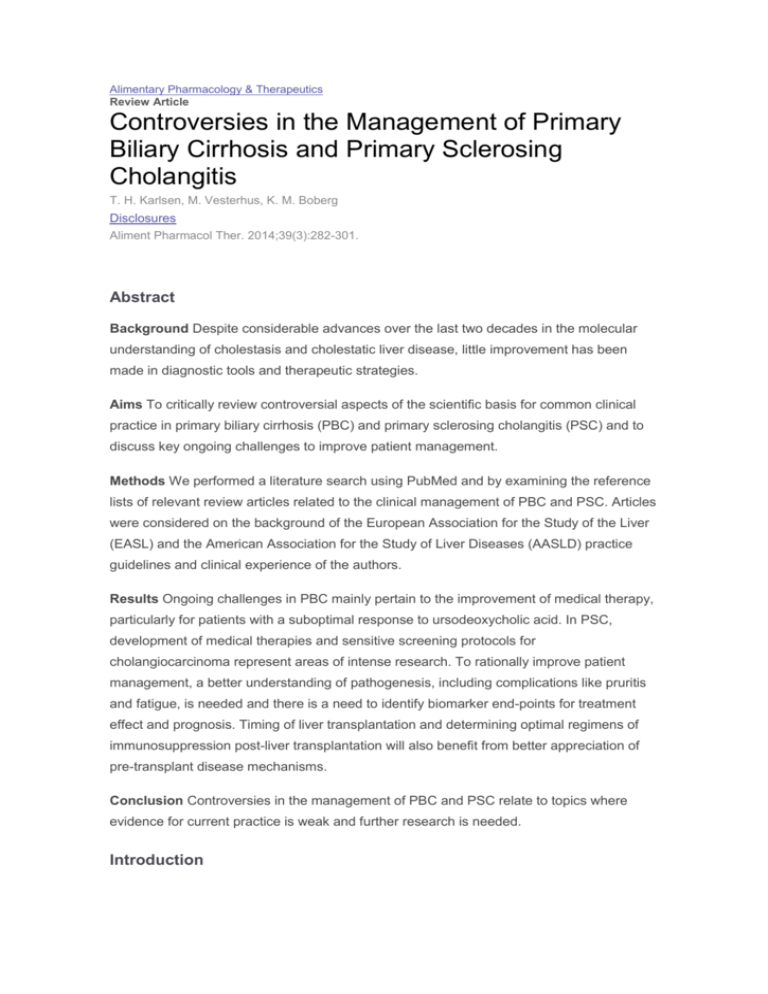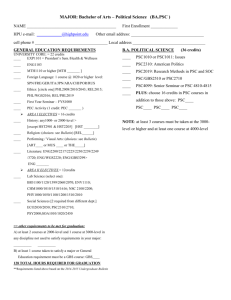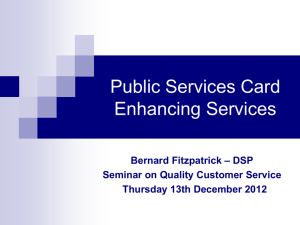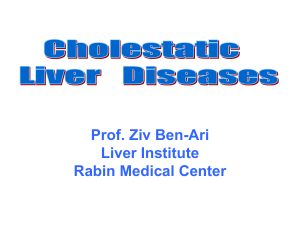Management of PSC
advertisement

Alimentary Pharmacology & Therapeutics
Review Article
Controversies in the Management of Primary
Biliary Cirrhosis and Primary Sclerosing
Cholangitis
T. H. Karlsen, M. Vesterhus, K. M. Boberg
Disclosures
Aliment Pharmacol Ther. 2014;39(3):282-301.
Abstract
Background Despite considerable advances over the last two decades in the molecular
understanding of cholestasis and cholestatic liver disease, little improvement has been
made in diagnostic tools and therapeutic strategies.
Aims To critically review controversial aspects of the scientific basis for common clinical
practice in primary biliary cirrhosis (PBC) and primary sclerosing cholangitis (PSC) and to
discuss key ongoing challenges to improve patient management.
Methods We performed a literature search using PubMed and by examining the reference
lists of relevant review articles related to the clinical management of PBC and PSC. Articles
were considered on the background of the European Association for the Study of the Liver
(EASL) and the American Association for the Study of Liver Diseases (AASLD) practice
guidelines and clinical experience of the authors.
Results Ongoing challenges in PBC mainly pertain to the improvement of medical therapy,
particularly for patients with a suboptimal response to ursodeoxycholic acid. In PSC,
development of medical therapies and sensitive screening protocols for
cholangiocarcinoma represent areas of intense research. To rationally improve patient
management, a better understanding of pathogenesis, including complications like pruritis
and fatigue, is needed and there is a need to identify biomarker end-points for treatment
effect and prognosis. Timing of liver transplantation and determining optimal regimens of
immunosuppression post-liver transplantation will also benefit from better appreciation of
pre-transplant disease mechanisms.
Conclusion Controversies in the management of PBC and PSC relate to topics where
evidence for current practice is weak and further research is needed.
Introduction
Cholestatic liver disease may arise due to defects at any level of bile formation. The
aetiologies of these conditions range from molecular abnormities caused by genetic
variation or drugs to structural changes due to developmental disorders, autoimmune bile
duct injury, tumours and gallstones. In everyday clinical practice, the term is most often
applied to primary biliary cirrhosis (PBC) and primary sclerosing cholangitis (PSC). Both
these conditions pose major management challenges in adult hepatology. In addition to the
general features associated with a broader syndrome of 'cholestatic liver disease' (e.g.
development of cholestatic liver cirrhosis) (Figure 1), disease specific pathologies (e.g.
malignancy risk in PSC) require attention. Considerable advances have been made over
the last two decades regarding the molecular understanding of cholestasis and cholestatic
liver disease.[1–5] These advances have largely derived from the identification of the genes
responsible for the progressive familial intrahepatic cholestasis (PFIC) syndromes
throughout the 1990s[6–9] and from the recent genome-wide association studies (GWAS)
applications in PBC and PSC.[10] Despite the new knowledge, little improvement has been
made in diagnostic tools and therapeutic strategies.
(Enlarge Image)
Figure 1.
The term 'cholestatic liver disease' jointly denominates the manifestations of a wide variety of liver
diseases. For most of the chronic cholestatic liver diseases, therapeutic opportunities are limited, resulting
in progression to liver cirrhosis and risk of cancer development. Disease-associated symptoms (e.g.
pruritus and fatigue) represent major clinical challenges. The focus of this review article is primary biliary
cirrhosis (PBC) and primary sclerosing cholangitis (PSC).
Primary biliary cirrhosis and PSC (Figure 2) are slowly progressive diseases with a course
of one to two decades from the manifestations of early stages of disease until end-stage
liver disease. This results in difficulties in establishing a robust level of evidence for the
benefit of any management option, including surveillance for complications throughout the
disease course. Prognostic modelling taking surrogate markers for disease stage [including
alkaline phosphatase (ALP), bilirubin, model for end-stage liver disease (MELD) score,
Child-Pugh score, histology and radiology] into account has, to some extent, assisted the
assessment in treatment trials, but robust markers for disease activity and disease
complications are missing. Interpretation of the present basis for patient management
requires caution and awareness of such limitations.
(Enlarge Image)
Figure 2.
Primary biliary cirrhosis (PBC) and primary sclerosing cholangitis (PSC) share features of an autoimmune
affection targeting different levels of the biliary tree. 14, 135 Co-occurring autoimmune manifestations outside
the liver are common in both conditions. In PSC, the increased risk of biliary tract- and colonic cancer
poses particular challenges. The present review elaborates on clinical challenges in PBC and PSC, as well
as each of the shared hepatic features shown in the figure. AMA, anti-mitochondrial antibodies; ANCA,
anti-neutrophil cytoplasmic antibodies.
In this review, we aimed to critically summarise the evidence for clinical practice in PBC
and PSC. The controversies that do exist arise on topics where evidence is weak or
conflicting and a further and better research is needed. Therefore, we will highlight both
controversies and important challenges. We will, to some extent, discuss general features
of cholestatic liver disease (cirrhosis development, pruritus and fatigue) and associated
molecular and genetic aspects. We will not provide comprehensive discussions on druginduced cholestasis and cholestatic liver disease in the context of developmental disorders
and gallstone disease, for which the interested reader is guided elsewhere.[11–13]
Methods
A literature search was conducted 1st September 2013 on PubMed using a
broad range of search terms including, but not limited to, 'primary biliary
cirrhosis' and 'primary sclerosing cholangitis' along with 'ursodeoxycholic
acid', 'treatment', 'clinical trial' and 'prognostic score'. Articles were selected
for discussion on the basis of the authors' prior knowledge on controversial
or challenging topics in the management of PBC and PSC. In addition,
important review articles, meta-analyses and Cochrane Systematic Reviews
were reviewed and examined for relevant references and practice
guidelines. Randomised clinical trials involving a treatment group (UDCA for
PSC, non-UDCA for PSC or PBC) vs. placebo or no treatment were included
for full table presentation irrespective of blinding or language. Observational
studies or studies lacking a control group were excluded from full table
presentation, but have been included in the main text to appropriately
account for controversial aspects where appropriate. Evaluation of predictive
models in PSC was limited to those assessing pre-transplant survival.
Articles may have been missed by the adopted approach, and the
presentation may also be biased as to the opinion of the authors.
Management of PBC
Diagnosis of PBC. The diagnostic criteria for PBC rely on the fact that the
targets of liver infiltrating T cells and the antibody production have been
identified as lipoylated domains of three members of the 2-oxo-acid
dehydrogenase complex family (mainly the E2 component of the pyruvate
dehydrogenase complex; PDC-E2).[14] The diagnosis can be made on the
basis of two of three criteria: the presence of biochemical cholestasis (ALP
elevation), detection of anti-mitochondrial antibodies (AMA) and typical
histological findings. A liver biopsy is not essential in patients with ALP
elevation and AMA, but may be required for the diagnosis of concurrent
features of autoimmune hepatitis and disease stage. There is little
controversy regarding the diagnostic criteria in PBC, but some discrepancy
in the evaluation of the level of evidence supporting these.
Depending on the assay employed,[15–17] 5–10% of patients with PBC present
without detectable AMA, even by repeated measures at follow-up. There is
little knowledge on the specific pathological features of AMA-negative PBC.
Other mitochondrial epitopes than M2 may be relevant.[18] There are also
slight differences in the cellular composition and severity of histological
lesions between AMA-positive and -negative cases.[19] Robust genetic
determinants to differentiate between AMA-positive and -negative PBC
patients have not been detected;[20] however, the AMA-negative subset of
patients is clearly too small to obtain conclusive statistical power in the
analyses. Clinical presentation and behaviour of AMA negative PBC is
largely similar to that of AMA-positive PBC,[21] and collated anecdotal data
suggest that there is also a similar response to ursodeoxycholic
acid.[22] Disease recurrence rates of PBC after liver transplantation also do
not seem to be affected by AMA status.[23] In clinical practice, the presence of
non-M2 immunoreactivity in a patient with PBC means that a liver biopsy is
required for diagnosis. Typically, considerations must also be made as to the
presence of small-duct PSC and genetic cholangiopathies,[24–26] and precise
distinctions between these conditions may not always be feasible.
Current Treatment of PBC. Therapeutic applications in PBC and other
cholestatic liver diseases can broadly be divided into bile acid therapy and
other approaches. Of bile acid preparations, doses of 13–15 mg/kg/day of
ursodeoxycholic acid (UDCA) appear beneficial and are commonly used in
PBC.[27–30]AASLD advises in favour of UDCA therapy judging evidence
unambiguously as class I (conditions for which there is evidence and/or
general agreement that a given diagnostic evaluation, procedure or
treatment is beneficial, useful and effective), level A (data derived from
multiple randomised clinical trials or meta-analyses). The EASL guidelines
evaluate the overall support for UDCA treatment at the same level, but
suggest that the evidence for long-term treatment is less robust (category II2; evidence for recommendation is derived from cohort or case–control
analytic studies, grade B; further research is likely to have an important
impact on our confidence in the estimate of effect and may change the
estimate, recommendation strong). This slight discrepancy may partly be
due to a still ongoing dispute as to the quality of trials performed and the true
efficacy of UDCA,[31] largely deriving from two negative Cochrane-based
meta-analyses of survival benefit from UDCA.[32,33] Another metaanalysis,[34]focusing on studies with long-term follow-up, however, claims a
significant improvement in transplant-free survival in patients on UDCA and
that duration of studies need to be taken into account when evaluating drug
efficacy in PBC. UDCA therapy also appears to be associated with reduced
costs compared with placebo/conservative treatment[28,35] and is by many
authorities considered standard care.
A favourable biochemical response to UDCA, incorporating specific
improvements in ALP ('Barcelona criteria'),[30,36] or in ALP, bilirubin and
aspartate transaminase (AST) ('Paris criteria'),[37] seems to associate with
improvement in transplant-free survival in PBC. In brief, the sum of these
biochemical responses and related assessments (e.g. the Mayo risk
score[38] and baseline parameters like ductopenia[39]) strongly suggests that
there is heterogeneity of the PBC patient population as to the efficacy of
UDCA. The mechanism of action of UDCA is reviewed elsewhere,[40] yet
which aspects of the pathogenesis of PBC that are reflected by
heterogeneity in the response to UDCA are unknown. For research
purposes, the response-indices may serve useful in stratifying patients in
studies aiming to determine the pathophysiology of such aspects. PBC
patients with little or no improvement in suggested response-indices are also
candidates for trials of supplementary or alternative therapies.
Future Treatment of PBC. No other bile acids than UDCA are currently in
use in clinical practice. Obeticholic acid, a derivative of chenodeoxycholic
acid, has (unlike UDCA) strong activating effects on the nuclear receptor
farnesoid X receptor (FXR) and is currently entering phase III clinical trials
following promising phase II results
(http://clinicaltrials.gov/ct2/show/NCT01473524).[41] A derivative of
UDCA,nor-UDCA, is currently in phase II clinical trials for PSC (see below),
but has not been tested in PBC. Of the nonbile acid therapies, bezafibrate
combination therapy with UDCA has shown the most promising
results[42,43] and is also at time of writing at the recruiting stage for phase III
trials (http://www.clinicaltrials.gov/ct2/show/NCT01654731). Like obeticholic
acid, bezafibrate exerts its likely main mechanism of action via nuclear
receptors, targeting the pregnane X receptor (PXR; also called the steroid
and xenobiotic receptor, SXR) and peroxisome proliferator-activated
receptor alpha (PPARα).[43] The glucocorticoid receptor agonist budesonide
also activates PXR.[44] Budesonide has shown some efficacy, which so far
has not translated into standard care,[45–48] largely due to concerns on
osteoporotic side effects.[49] In our opinion, glucocorticoid receptor-centred
adjuvancy to UDCA in PBC should be restricted to patients with features of
autoimmune hepatitis (see below).
In many ways, PBC is a prototypical autoimmune disease,[14] with a welldefined autoantigen, a relatively homogenous disease expression and a
genetic susceptibility background similar to that of other autoimmune
diseases (Figure 2).[50] For this reason, the poor efficacy of immune-targeted
therapies that have been tested so far (Table 1) remains somewhat of a
paradox. There is little controversy as to this observation, yet there is
renewed interest in immune-target therapies on the basis of specific
pathways highlighted by GWAS findings. Phase II trials on ustekinumab (a
monoclonal anti-p40
antibody, http://www.clinicaltrials.gov/ct2/show/NCT01430429) are ongoing
based on the prominent genetic associations with several components of the
interleukin 12 (IL12) and IL23 signalling pathway in the study populations of
European ancestry.[51,52] As a note of caution in this regard, the biological
implications of these genetic associations are as of yet not understood.
Moreover, they seem not to be a prerequisite for PBC development as
shown by the absence of similar associations in Asian study
populations.[53] The efficacy of ustekinumab in other IL12/23-related diseases
varies; e.g. in psoriasis, ustekinumab is part of the established treatment
armamentarium,[54] whereas in multiple sclerosis, it has been concluded to be
of no benefit.[55] As the relationship between this response heterogeneity and
the genetic associations in implicated diseases is unknown, efficacy in PBC
of ustekinumab and similar approaches is hard to predict.
A definite controversy in PBC exists as to the possibility of an infectious
aetiology.[56,57] It is beyond the scope of this article to review the scientific
basis of this dispute, which has triggered the execution of completed [58] and
planned (http://clinicaltrials.gov/ct2/show/NCT01614405) anti-retroviral
regimens. As of yet, there is no proven benefit of such approaches. In
epidemiological data (reviewed elsewhere),[59]associations have also been
suggested between exposure to urinary tract pathogens (Novosphingobium
aromaticivorans in particular) and other potential environmental co-factors
for the ongoing immune response in PBC. Of particular interest is 2-Octynoic
acid,[60] which is present in commonly used cosmetic products and food
flavourings and has the potential to modify PDC-E2 in an immunogenic
direction. Elimination studies, like for gluten in coeliac disease, have not yet
been performed to justify any particular advice on 2-Octynoic acid-related
products for patients.[61] Unlike the case in PSC, antibiotic therapy in PBC
has not been attempted outside the context of pruritus (rifampicin). [62,63] Of
the reported environmental risk factors in PBC,[64] smoking seems to be the
only one to be accounted for in clinical counselling so far, given associations
with an increased rate of liver fibrosis.[65,66]
Liver Transplantation in PBC. In general, disease progression is more
predictable in PBC than in PSC, and the utility of prognostic models
(bilirubin, Mayo risk score and MELD, in particular) in the appropriate timing
of liver transplantation is established.[67–69] Pruritus may, in a few cases,
serve as the sole indication for liver transplantation. The improvement of
fatigue following liver transplantation is less predictable and pronounced
than other symptoms,[70,71] and fatigue should, therefore, not trigger liver
transplantation without the presence of other indications. There is little or no
controversy as to incorporating symptomatic indications in the transplant
assessments, even in areas with MELD-based graft allocation programmes.
Hepatocellular carcinoma (HCC) may develop in PBC patients with
advanced disease stages,[72,73] and may also be associated with
nonresponse to UDCA.[74] The patients should be followed accordingly.[75–77]
Disease recurrence occurs in up to 30–35% of liver allografts in PBC
recipients.[78] The variable frequencies between studies probably reflect
differences in practice as to protocol biopsies and diagnostic criteria. There
is no consensus as to treatment of UDCA in transplant recipients with
recurrent PBC, but hepatic biochemistries improve upon administration like
in the native liver disease.[78–80] Whether the choice of calcineurin inhibitor
influences recurrence rates is debated.[81] Tacrolimus seems to associate
with higher frequencies of recurrence and shorter recurrence-free survival
than ciclosporine in many series.[81] Meta-analysis of available data as of
January 2006, however, did not support a significant difference in PBC
recurrence rates according to immunosuppressive regimen. On this basis,
and as short- to mediate-term impact on overall and graft survival from PBC
recurrence is neglible,[82] tacrolimus-based regimens remain standard at
most centres. As very long-term (>10–20 years of follow-up) impact from
PBC recurrence on re-transplantation rates is unknown, further
considerations may become relevant as data accumulate.
Management of PSC
Diagnosis of PSC. There is emerging evidence that previous estimates of a
frequency of PSC in IBD of 2–4% may be too low and that up to 10% of
patients with IBD may show changes compatible with PSC on magnetic
resonance cholangiography (MRC).[83,84] The association between IBD and
PSC remains one of the key features of PSC for which the basis is still not
established. Hypotheses range from endotoxin leakage,[85] via pathogenic
changes to the gut microbiota,[86] to aberrant homing of intestinally activated
lymphocytes to engage in biliary inflammatory processes.[87,88] If the
pathological processes involved can be dissected, it may be possible to
develop diagnostic tools for early, potentially pre-clinical, detection of PSC in
IBD patients. On the other hand, it is currently not known to what extent
failure of medical therapy in PSC can be ascribed to an advanced disease
stage with manifest strictures already at the time of diagnosis. As of yet,
procedures to diagnose PSC are restricted to IBD patients in whom
abnormal regular biochemical tests suggest the presence of liver disease.
There is now consensus in both AASLD and EASL guidelines that MRC is
the method of choice, unless endoscopic interventions or sampling is called
for and endoscopic retrograde cholangiography (ERC) is indicated. Likely,
the practice is sound, but IBD patients with normal biochemistries in whom
an intensified colorectal screening programme could be justified if they
proved to have PSC will be missed by this approach.[83]
The topic of elevated levels of immunoglobulin G4 (IgG4) in 10–20% of
patients with PSC has received much attention over the last years.[89–93] An
unknown fraction of these patients is likely to have cholangitis in the context
of autoimmune pancreatitis (AIP) as determined by the HISORt criteria[94] first
reported in Asian populations.[95,96] Modified criteria have been adopted for
the application in patients with PSC, i.e. accounting also for patients with two
or more main manifestations (elevated serum IgG4, suggestive pancreatic
imaging findings, other organ involvement and bile duct or papilla Vateri
biopsy with >10 IgG4 positive cells/hpf) in combination with a significant
corticosteroid treatment response defined as markedly improved biliary
strictures allowing stent removal, liver enzymes <2 × ULN and significant
decreases in serum IgG4 and CA19–9 levels.[97] Corticosteroid
responsiveness is a central feature of these criteria. Serum IgG4 levels are
also typically higher in patients with AIP than in PSC, although precise cutoff levels for serum IgG4 to distinguish the conditions are not firmly
established.[98]It may be argued that IgG4 elevations in PSC arising outside
the context of AIP is of uncertain importance and associates with
pathogenetic processes in PSC per se.[99,100] On the other hand, it has been
suggested that disease behaviour in patients with PSC and even mild
elevations of IgG4 shows atypical features, which include a more rapid
disease progression.[90,101] A pragmatic approach is to adopt IgG4
measurements as part of the routine diagnostic work-up of patients with
suspected PSC (as already proposed by EASL and AASLD
guidelines),[67,102] and to keep the threshold at a reasonable level when
selecting suspected cases for assessment of corticosteroid
responsiveness.[97] Until refined criteria are available, sound clinical
judgment, also accounting for corticosteroid side effects, is needed to guide
decisions on the topic.
Cancer Surveillance in PSC. Historically, it is of interest to note the 10
years that passed from the first report on an increased risk of colorectal
cancer in PSC[103] until the association was corroborated in meta-analysis of
available and contrasting reports.[104] Colorectal cancer surveillance annually
or biannually in PSC patients with IBD is now advised in both the EASL and
AASLD guidelines. PSC presentation may precede that of IBD, and IBD may
even present post-liver transplantation.[105]Furthermore, IBD in PSC typically
runs a quiescent course,[106–108] and may thus be missed. Regular reevaluation by total colonoscopy and histology, for instance every 4–5 years,
is therefore recommended by many authorities.
We recently reviewed the present data on diagnosis of cholangiocarcinoma
in PSC.[109] The main problem is that of early diagnosis, and so far, there are
no consensus guidelines as to robust screening protocols. A recent
population-based patient series from the Netherlands questions previous
notions that late presentation of cholangiocarcinoma is a rare event, [110] with
37% of cholangiocarcinomas presenting more than 10 years after diagnosis
of PSC.[111] Clinical and biochemical deterioration at any point in the disease
course should therefore always result in reflections as to a potentially
malignant explanation. There is some evidence that imaging routinely should
be incorporated in PSC patient follow-up,[112] and MRC or ultrasound is
included in patient follow-up at many centres. The EASL guidelines advise
for annual ultrasound to detect gall-bladder mass lesions,[67,113] but neither
this practice nor the utility of other imaging modalities in early
cholangiocarcinoma detection has so far been validated. The ability
of FUT2/FUT3 genotyping to improve CA19–9 test performance also needs
prospective evaluation and validation.[114]
With few exceptions, investigations of brush cytology specimens, obtained at
ERC by brushing in a region of a suspicious stricture, have a specificity of
90–100% for cholangiocarcinoma in PSC in published series (Table 2). The
problem with the method is highlighted by the variable sensitivity. Operator
variability as well as differences in the criteria defining a positive test is likely
to contribute to the variable sensitivity.[115] Technical aspects of brushing at
ERC and intrinsic variability in cholangiocarcinomas may also play a role.
Repeated brushings can improve the sensitivity of this method,[116] a practice
also employed at our centre on inconclusive findings in a suspicious clinical
context. As shown in Table 2, various means of structural chromatin/DNA
assessments, by fluorescent probe hybridisation, digitised image analysis or
flow cytometry, generally improve sensitivity and are incorporated in clinical
routine diagnostics of brush cytology specimens at many referral centres. As
reviewed elsewhere,[109] molecular biomarkers for cholangiocarcinoma in
PSC are awaited and expected to improve sensitivity even further. However,
the path forward to clinical validation of these makers is likely to still take
some years, due to scarcity of patients and only recent establishing of
systematic prospective patient biobanking in the international PSC research
network (www.ipscsg.org).
Current Medical Treatment of PSC
The AASLD guidelines advise against the use of UDCA as medical therapy
in PSC, concluding at a class I, level A recommendation (see above for
criteria definitions).[102] The EASL guidelines have a more compound
conclusion, suggesting that UDCA improves serum liver tests and surrogate
markers of prognosis, but does not reveal a proven benefit on survival. Thus,
they conclude that present data do not yet allow a specific recommendation
for the general use of UDCA in PSC.[67] The controversy surrounding UDCA
use has several reasons. These partly derive from the lack of effect on
clinical end-points in partly underpowered clinical trials (Table 3) and partly
from a study using a high dose of UDCA (28–30 mg/kg/day), which
culminated in an increase in clinical end-points including colorectal
dysplasia.[117,118] There is an increasing enrichment of biliary UDCA in
patients with PSC, from 43–47% at normal doses (10–17 mg/kg/day) to 56–
59% at higher doses (18–32 mg/kg/day),[119] along with increased delivery of
unabsorbed UDCA to the colon for bacterial metabolisation. The
mechanisms explaining the detrimental effects of high-dose UDCA have not
been fully elucidated and conflicting pilot data on high-dose UDCA in PSC
do exist.[120,121] In effect, many centres still offer UDCA to patients on the
basis of clinical experience and tradition and argue that only the high-dose
UDCA regimen should be abandoned.[122] To what extent UDCA-responsive
subsets of PSC patients can be defined (e.g. on the basis of ALP changes
like in PBC[123]) is not yet clear.[124,125]
Future Medical Treatment of PSC. Like in PBC, there is no other bile acid
than UDCA in clinical use for the treatment of PSC. Based on promising
phase I and animal data,[126–128] nor-UDCA is currently in phase II clinical trials
(http://clinicaltrials.gov/ct2/show/NCT01755507). A variety of
immunosuppressives, antibiotics and other compounds have been tested
over the years, often in the context of poor study design and in trials of
limited duration. However, some trials are of comparable size and quality as
the trials evaluating the use of UDCA in PSC (Table 4). More recently, there
has been a renewed interest in antibiotic treatment,[86,129] largely deriving from
rapidly emerging data regarding the interrelationship among bile acid
metabolism, systemic and mucosal inflammation and the gut microbiota. [130–
133] However, specific roles for the gut microbiota in PSC pathogenesis, albeit
an intriguing possibility, are still devoid of robust experimental support.
Furthermore, knowledge may emerge on specific mechanisms for which
broad antibacterial interventions like antibiotics may not represent the
appropriate treatment approach. Therapies targeting fibrogenesis are also of
interest in PSC, e.g. lysyl oxidase-like
2[134] (http://clinicaltrials.gov/ct2/show/NCT01672853). There is little
controversy as to the application of widely variable treatment approaches in
PSC, given uncertainties that still exist regarding pathogenesis.[135] Clinical
trials are hampered by inherent limitations such as a slowly progressing
disease and lack of applicable prognostic indices (Table 5). This includes a
lack of or consensus protocols for assessing disease progression by
available imaging modalities (MRC, transient elastography).[136–140] The
outcomes of ongoing clinical trials are therefore likely to have flaws intrinsic
to study design and disease behaviour as much as choice of treatment
targets.
Endoscopic Treatment in PSC. There are also differences in the practice
preferences related to the main treatment options for PSC, comprising
endoscopic interventions and liver transplantation. For endoscopy, an
ongoing trial aims to clarify whether balloon dilatation or short-term (2–3
weeks) stenting is the preferable management for bile duct strictures
(http://clinicaltrials.gov/ct2/show/NCT01398917). Both strategies are in
current practice,[141,142] yet the additional value of stenting is not established
and has been claimed to associate with increased frequencies of
cholangitis.[143] As to either approach, the threshold for intervention is often
left at the discretion of the endoscopist, a decision likely to be biased by
spontaneous fluctuations in bile flow and cholestatic parameters in PSC.[144]
Liver Transplantation in PSC. Pruritus, more rarely, is the sole indication
for liver transplantation in PSC compared with PBC due to correlation of
pruritus with biliary stricture severity to a larger degree in PSC than in PBC.
The appropriate timing of liver transplantation for PSC vs. the risk of biliary
dysplasia and cancer is more complex.[145] The EASL guidelines consider
cholangiocyte dysplasia as well as severe recurrent bacterial cholangitis as
potential indications for liver transplantation. The AASLD guidelines have a
notion of liver transplantation with neoadjuvant chemotherapy and
brachytherapy ('the Mayo protocol'),[102] but do not specifically consider biliary
dysplasia. In the Nordic countries, which do not have MELD-based organ
allocation, biliary dysplasia detected by brush cytology may serve as the
sole indication for liver transplantation. The practice has been criticised on
the basis that 1/3 of PSC patients may exhibit cholangiocellular dysplasia in
the absence of cholangiocarcinoma, and further validation is needed.[146–
148] Clearly, upon improvements in biomarkers for early cholangiocarcinoma
detection, an evidence-based shift toward earlier transplantation in these
patients will be feasible. As of yet, decision-making is largely based on the
experience and preference of each individual transplant programme.
Immunosuppressive regimens in liver-transplanted PSC patients are now
mainly tacrolimus-based.[149,150] There is no firm evidence that the choice of
immunosuppressive regimen directly affects risk of PSC
recurrence.[81,149] However, there is an, as of yet not fully understood,
interrelationship between post-transplant IBD activity (requiring intensified
corticosteroid treatment) and increased PSC recurrence rates.[149,151] A
cause–effect relationship between IBD activity and PSC occurrence (or,
more appropriately, re-occurrence) is adopted by most authors as the most
likely explanation, but alternative mechanisms (e.g. intrinsically high disease
activity of both bile duct and colonic inflammation) may also prove correct.
There is also a relationship between acute cellular rejection (against which
corticosteroids would protect) and PSC recurrence.[152] The topic is of
considerable interest as long-term follow-up indicates that PSC recurrence
does increase re-transplantation rates.[153] Interpreting the relationship
between disease recurrence and immunosuppression is further complicated
by associations between tacrolimus-based regimens and IBD flares following
liver transplantation in PSC.[154–156] As of yet, evidence does not allow for firm
recommendations either on timing of colectomy (pre-transplant in patients
with high-activity IBD pre-transplant?) or choice of immunosuppression
(ciclosporine-based regimens in patients with high-activity IBD posttransplant?). Likely, on a more comprehensive appreciation of disease
mechanisms in PSC and IBD in PSC, immunosuppression regimens postliver transplantation in PSC that accounts not only for allograft rejection
issues but also for PSC immunopathology can be designed.
Common Features in PBC and PSC
Autoimmune Hepatitis. A consensus document from the International
Autoimmune Hepatitis Group (IAIHG) deals thoroughly with the controversy
as to whether 'overlap syndrome' (Figure 2) should be considered a separate
disease entity.[157] If the patients fulfil a diagnosis of PBC or PSC, this should,
according to this consensus document, be the primary diagnosis and cooccurring features of autoimmune hepatitis should be determined using
general considerations (ALT at least 5× ULN, IgG at least 2× ULN,
histological features of autoimmune hepatitis) rather than the IAIHG scoring
systems.[158]Identification of patients for corticosteroid therapy is not
straightforward. Treatment response to corticosteroids in PSC and PBC
patients with concomitant features of autoimmune hepatitis is generally less
pronounced than in patients with autoimmune hepatitis as the primary
diagnosis,[159,160] and more so in PSC than in PBC.[161,162] It is thus important to
be aware of the risk of side effects (osteoporosis in particular) and to assess
treatment response regularly, as well as to consider steroid sparing agents
for patients requiring long-term treatments.[67]
Cholestatic Liver Cirrhosis. To what extent defects of bile acid
homoeostasis involve in the primary insult in PBC and PSC is still
debated.[163] Regardless of the aetiological basis of bile duct injury in PBC
and PSC, development of liver fibrosis throughout the disease course most
likely involves bile acid toxicity at some level.[1] The hepatocyte initiates
adaptive responses during cholestasis (Figure 3), including the (i)
downregulation of bile acid synthesis and hepatocellular bile acid uptake, (ii)
increased hydroxylation and conjugation to make bile acids more water
soluble and (iii) induction of bile acid efflux pumps on the sinusoidal
membrane leading to export of metabolised bile acids to the systemic
circulation for renal elimination. Together with FXR and PXR, the constitutive
androstane receptor (CAR) is a major determinant of the expression of the
genes involved in this adaption.[164,165] The concept of directing or augmenting
these adaptive mechanisms during cholestasis forms the basis of several
ongoing treatment trials (e.g. obeticholic acid), but so far remains to be
proven. At the level of the cholangiocyte, several lines of evidence converge
on the importance of apical bicarbonate secretion (the bicarbonate 'umbrella'
hypothesis) in preventing the protonation of luminal bile acids and thus
reducing cellular injury.[163,166] The bile acid receptor TGR5 is involved in
these mechanisms, but so far therapeutic efficacy for TGR5 agonism in
cholestatic liver disease seems to occur in conjunction with FXR
effects.[167] Importantly, the risk of accelerating cholangiocarcinoma
development argues against human applications of TGR5 agonists in
PSC.[167] The role of the gut microbiota in modifying the cholestatic bile acid
pool within the enterohepatic circulation and vice versa also needs to be
defined (Figure 3).[130–133]
(Enlarge Image)
Figure 3.
Traditions of bile acid research and the concept of 'bile acid toxicity' serve as the main
basis for present therapies in primary biliary cirrhosis (PBC) and primary sclerosing
cholangitis (PSC), as well as for most of the ongoing treatment trials. At the level of the
liver, protective mechanisms in a context of cholestatic liver disease involve regulation of
bile acid transport and metabolism (red, downregulation generally beneficial; blue,
upregulation generally beneficial). At the level of the bile ducts, protective mechanisms
involve apical bicarbonate secretion by the cholangiocytes (blue). There is emerging
evidence that the gut microbiota, during the intestinal phase of the enterohepatic
circulation, influences these mechanisms and serves additional regulatory mechanisms.
There is an ongoing controversy in PBC and PSC as to the importance of these
mechanisms as compared with primarily immune-mediated liver and bile duct injury. Cyp
(cytochrome P450), UGT (uridine diphosphate glucuronosyltransferase), SULT
(sulfotransferase), GST (glutathione S-transferase), BSEP (bile salt export pump), MRP2, 3
and 4 (multidrug resistance-associated protein 2, 3 and 4), MDR3 (multidrug resistance
protein 3), OST (organic solute transporter, OSTα-OSTβ heterodimer), ASBT (apical
sodium-dependent bile acid transporter), IBABP (ileal bile acid-binding protein), NTCP
(Na+-taurocholate cotransporting polypeptide), OATP (several organic anion transporting
polypeptides), CFTR (cystic fibrosis transmembrane conductance regulator), AE2 (anionic
exchanger 2), TGR5 (Takeda G-protein coupled receptor 5).
Pruritus. The large number of candidate pruritogens in cholestatic liver
disease launched over the years is reviewed elsewhere.[168–170] More recently,
two groups have reported on slightly differing aspects of cholestatic
pruritus.[171,172] An Amsterdam group identified lysophosphatidic acid (LPA) as
a pruritogen produced by autotaxin[171] and associating with itching behaviour
in mice. In humans, the serum activity of autotaxin correlated with itch
intensity and was reduced upon treatment with nasobiliary drainage. Similar
correlations were not observed for bile salts, in contrast to findings recently
reported from a San Francisco group, which detected correlations with
itching behaviour and TGR5 activation status.[172] Intradermal injection of bile
acids and a TGR5-agonist induced itch behaviour in the experimental setup,
which also included detection of reduced itch behaviour in tgr5-/- mice and
spontaneous itching behaviour in TGR5 overexpressing mice. The main
criticism against the TGR5 data pertains to the doses of deoxycholic acid
used in the experiments,[170] which range far above physiological
concentrations in cholestasis.[173] Furthermore, the concentrations used to
elicit itching in vivo may also induce mast cell degranulation and thus cause
itching via non-TGR5 mechanisms.[174]Further studies are likely to elaborate
on both TGR5 and autotaxin-associated aspects of pruritus and thus
potentially open up for novel treatment options.
Fatigue. The pathogenetic basis for fatigue in cholestatic liver disease,
sometimes pronounced and debilitating, is not known. The most pronounced
affections occur in PBC, where more than half of the patients have been
reported to suffer from fatigue.[175,176] Many of these patients report fatigue to
represent the predominant cause of reduced quality of life.[177–179] The range
of causes proposed to cause fatigue in PBC is large and reviewed
elsewhere.[180] Like in pruritus, a consensus biological explanation of fatigue
is as of yet lacking. In neither PBC nor PSC is there a correlation of fatigue
with severity or stage of liver disease.[176,181] The cause vs. effect relationship
between fatigue and social and psychological complications to the disease
burden is hard to dissect.[178,181] In lack of therapeutic means, appropriate
recognition and handling of such complications are likely to be the most
efficient management option.
Conclusions
There are several scientific traditions running in parallel within the topic of
cholestatic liver diseases, predominantly represented by research involving
bile acids, liver immunology and luminal gastroenterology. The strategic
priorities for research over the years are coloured by these traditions,
sometimes emerging as controversies on topics where traditions and
research outcomes point in different directions. Often, however, discussions
are also flavoured by personal preferences and experience that may
contrast that of frequently limited scientific evidence. The topics in lack of a
consensus should serve as focus areas for further research. The
discussions should translate into better study designs and renewed efforts to
dissect these topics. As to clinical practice in areas of uncertainty, and even
controversy, pragmatic considerations are often required. Rational guidance
has now also been provided by the EASL and AASLD practice
guidelines.[67,68,102] Major challenges for future research relate to the accurate
assessment of disease activity and progression to allow for evaluation of the
treatment effect in clinical trials. Still, PBC and PSC patients account for
almost 10% of the European liver transplant programme, highlighting the
need for intense research into disease pathophysiology as a basis for novel
treatment options. Cholangiocarcinoma represents the cause of death in up
to half of the PSC patients, and biomarkers for early detection are sorely
needed in this population.
Multiple initiatives in the international community are presently acting upon
these topics, and there is also increased appreciation from the broader
community (EASL and AASLD) as to the importance of improving patient
management in cholestatic liver disease. We anticipate that some of the
hurdles will soon be overcome, but as of yet, we have to care for the patients
on the basis of sometimes conflicting or even lacking scientific evidence.








